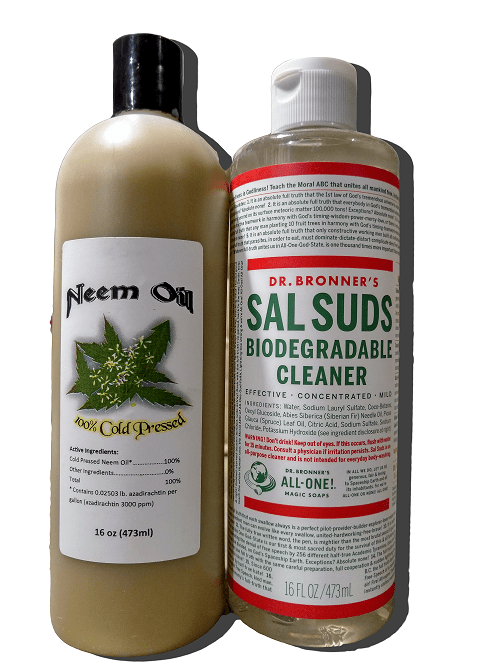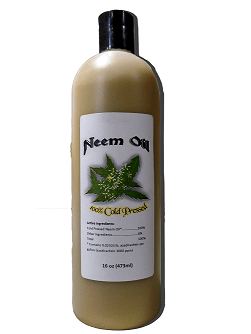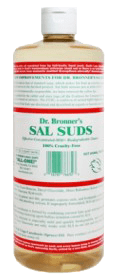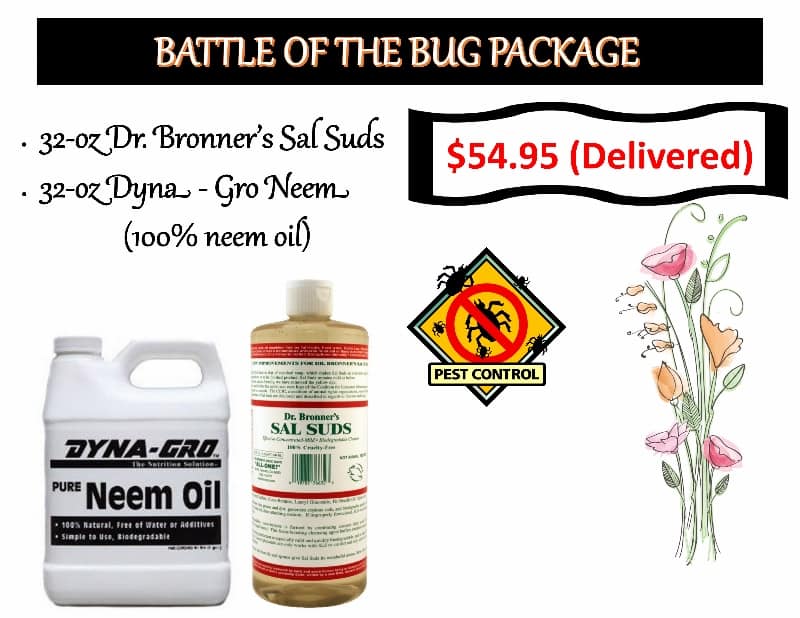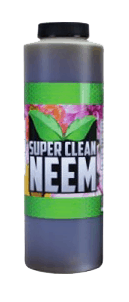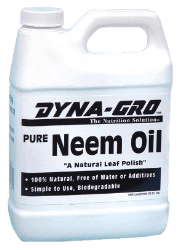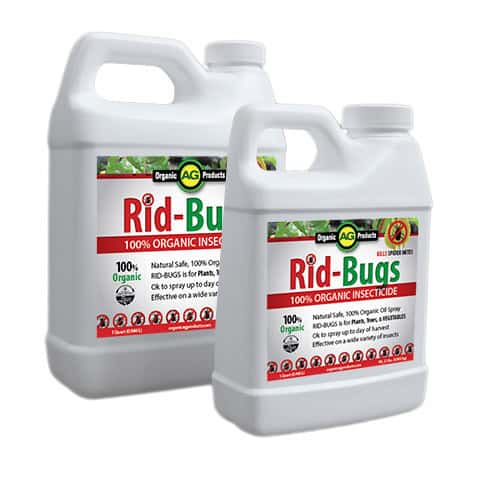Organic Pest Control Recipe
The last word on natural and safe pest control!Together, these safe, natural and highly-effective products will help you to win your own personal garden’s pest-pressure problems. Once and for all!
John from “growingyourgreens” shares his proven methods to control pests in your organic vegetable garden. In this epsiode, John shares with you his top ways to prevent a pest infestation in the first place, and then shares his techniques for dealing with bugs in the garden. Next, special guest, Josh from Boogie Brew will enlighten you on why chemical pesticides should not be used in your garden and the safe, effective #1 alternative to get proven results to rid the pests from your garden once and for all.
Recommended Application Rates
Dr Bronner’s Sal-Suds Soap: 2 Tbps/gallon
Neem Oil: 2 Tbps/gallon
Rid-Bugs or other essential oils (optional): 10 drops/gallon of each essential oil.
NOTE: Use the basic formula of neem + soap weekly as a good all-around preventive tonic and up to 3 times weekly for more serious infestations.
(Boost your spray with essential oils as needed for reproductive control.)
Ultimate “Boogie-Bug” & Powdery Mildew Recipe:
1) Use 2 tablespoons, (per gallon), of Neem oil with an equal quantity, (1:1), of Dr Bronner’s “Sal-Suds” brand soap, (this particular Dr Bronner’s soap can be found in your local health-food store’s laundry and dish-detergent section; it is very kind to both plants and the environment).
2) SHAKE a small jar of warm water with the Neem oil and soap added to the jar first. Shake the contents thoroughly until the oil has become completely emulsified by the Dr Bronner’s Sal-Suds soap.
3) Pour the resulting concentrated “Neem-Milk” liquid into your 1 or 2 gallon sprayer and then go to town spraying your plants’ entire leaf foliage; they will love you for it! Use this ultra-effective recipe anywhere from 1 to 2 or even 3 times per week, (depending on pest or disease pressure). Occasionally “boost” the above recipe with Pure-Protein to add additional fertilizing value to your spraying regime.
Plants just seem to LOVE the combination of these natural pesticides with PURE PROTEIN. This sort of application could easily transform chemical farming’s addiction to toxic and dangerous pesticides which have been poisoning America’s landscape for decades!
The fatty acids & aminos in PURE-PROTEIN work to fortify plant tissue from pests & pathogenic organisms. By using PURE-PROTEIN and Boogie Brew together as a foliar SUPER-SPRAY, you will create a highly-effective armor-plating of easily absorbed, 100% free-form amino-acids which, together with Boogie’s beneficial organisms, form a PROBIOTIC DEFENSE SHIELD for plants.
100% COLD-PRESSED NEEM OIL 32OZ
DR. BRONNER’S SAL SUDS
coming back soon!
SUPER CLEAN NEEM 16OZ
coming back soon!
DYNAGRO NEEM OIL 32OZ
coming back soon!
Organic Pest Control – End Problems with Bugs Forever in Your Garden
The tolls on human health and our environment from pesticides are horrendous and completely unnecessary to boot! After many years of trial and error, while trying-out a multitude of natural pest-control agents, Boogie’s own highly recommended bug-battling formula involves the use of two crucial ingredients: by using Dr Bronner’s Sal-Suds Soap & Clean Neem Oil, (mixed together and ideally applied with a Hudson Atomizing Fogger machine, or at the very least a high-quality pump/back-pack sprayer),any grower can achieve astounding success in their garden against invasive bug species all at ZERO cost to human or planetary health. Use these two outstanding items together and on a regular basis, (weekly or more often for serious pest pressure problems), and you too can win just about any bug-battle, in a simple, non-toxic and ultra-safe manner!
Annihilate pests and their eggs too!
To truly wipe out invasive-bugs, many people feel that it is necessary to completely destroy their eggs too: In certain situations, we have seen such a need for an even stronger recipe, (neem and sal-suds DO work, but it can take longer and may require multiple applications, etc.) For this purpose, Boogie Brew also recommends the additional usage of a blend of essential oils made from rosemary and clove (Optional: Orange and Peppermint). This is an open source product that you make from 10 drops clove oil, 10 drops Rosemary oil (and 10 drops of other optional oils). Boogie suggests that you occasionally BOOST your Bug-Battling clean neem oil and Dr Bronner’s Sal-Suds formula with the additional egg-destroying power of essential oils.
Neem Oil General Fact Sheet
Bond, C.; Buhl, K.; Stone, D. 2012. Neem Oil General Fact Sheet; National Pesticide Information Center, Oregon State University Extension Services. http://npic.orst.edu/factsheets/neemgen.html.
What is Neem Oil?
What are some products that contain neem oil?
Always follow label instructions and take steps to avoid exposure. If any exposures occur, be sure to follow the First Aid instructions on the product label carefully.
How does neem oil work?
What are some signs and symptoms from a brief exposure to neem oil?
In other countries, neem oil has been used on cats for flea control. Some adverse reactions have been reported. Symptoms include feeling sluggish, excessive salivation, impaired movement, trembling, twitching, and convulsions. Some of the cats died. However, most of them recovered within 1 to 5 days.
What happens to neem oil when it enters the body?
In one study, scientists injected insects with azadirachtin. They found 90% of the dose in the insects’ feces within 7 hours. The remaining portion lingered in the insects’ bodies for 24 days after the injection.
Is neem oil likely to contribute to the development of cancer?
Further, one study found that certain components of neem oil caused cancer cells in hamsters to stop growing or die. Another study looked at prostate cancer cells from humans. Researchers found that neem leaf extract was able to slow their growth.
Has anyone studied non-cancer effects from long-term exposure to neem oil?
Are children more sensitive to neem oil than adults?
What happens to neem oil in the environment?
Can neem oil affect birds, fish, or other wildlife?
If problem insects persist spray again In 5 to 7 days.
RID-BUGS
100% ORGANIC INSECTICIDE
OKAY TO SPRAY UP TO HARVEST
100% CONCENTRATE MAKES 64 SPRAYS
EFFECTIVE on eggs, larva, and Nymphs of insects as well as, adult softbodied insects. Controls a wide range of mite and insect pests such as (but not limited to) citrus rust mites, spider mites, two spotted mites, armored and soft scales, mealey bugs, whiteflies, aphids, leaffollers, leaf miner, fungus, gnants and thrips. RID-BUGS ORGANIC INSECTICIDE controls certain fungal diseases such as (but not limited to powdery mildew, black spot on roses, helminthosporium and grease spot on citrus.
Target Plants:
Vegetables, fruits, nuts, vine groups, herbs, spices, ornamentals, greenhouse crops, turfgrass, landscape plants, interior plants, bulbs, flowers and field crops.
Plant Compatibility:RID-BUGS ORGANIC INSECTICIDE has a high degree of safety to most plants.
However, some plants in the Euphorbia family (Crown of Thorns) have shown some sensitivity. If in doubt, treat a small section of the plants before wide scale use.
Versatile: Controls mites, some scale, some fungal diseases, aphids and fungal diseases, like powdery mildew & rust on roses.
Safety:Replaces many “HARD” Pesticides No Re-Entry Time Required.
Effective:controls Sago Palm Scale Plant Safe.
Dosage rates: For small batches use 2 ounces per gallon of water. Use a sprayer that will put out a fine mist spray.
For Sago Palm Scale: make three or more applications one week apart.
Spray the trunk as well as the foliage (both sides). Complete coverage is necessary.
Spray two times per month to prevent scale from returning.
Tank mix: 2 gallons per 100 gallons of water/Acre Mix thoroughly. If other pesticides are to be added, do so after mixing RID-BUGS ORGANIC INSECTICIDE.

